An Overview of Prenatal Development: Stages and Influences
VerifiedAdded on 2023/06/03
|9
|1727
|349
Essay
AI Summary
This essay provides a comprehensive overview of prenatal development, beginning with an introduction to the process and its stages. The discussion delves into the three primary stages of prenatal development: the germinal, embryonic, and fetal stages, detailing the physical changes and developments that occur in each. It then explores cognitive development, highlighting how the fetus responds to its environment and the potential impact of maternal stress and anxiety on the child's neuropsychological functioning. The essay also examines psychosocial development, referencing Erikson's theory and emphasizing the influence of the mother's emotional state on the fetus. The conclusion underscores the significance of the prenatal period and its lasting effects on the child's temperament, behavior, and social development. The essay also references key studies and research papers.
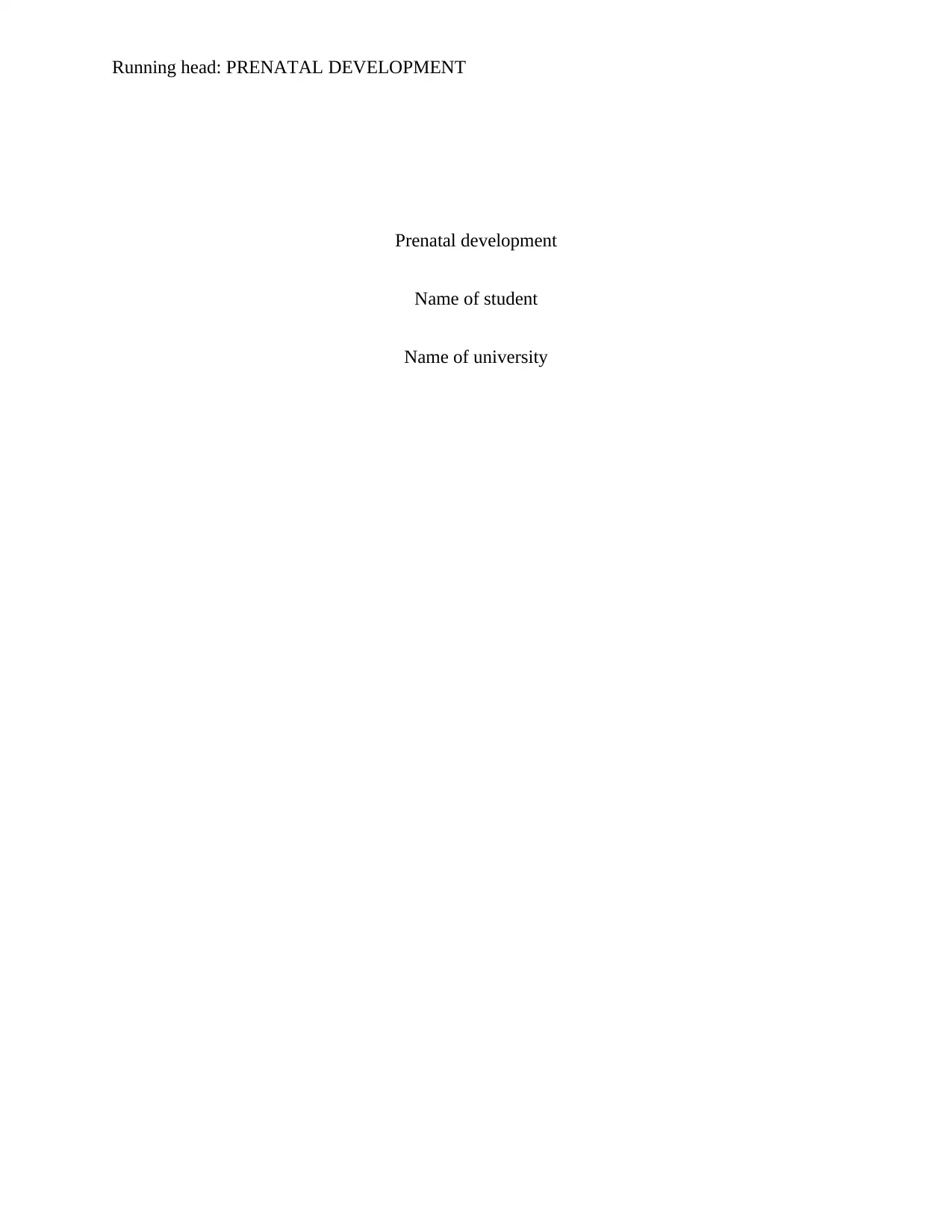
Running head: PRENATAL DEVELOPMENT
Prenatal development
Name of student
Name of university
Prenatal development
Name of student
Name of university
Paraphrase This Document
Need a fresh take? Get an instant paraphrase of this document with our AI Paraphraser
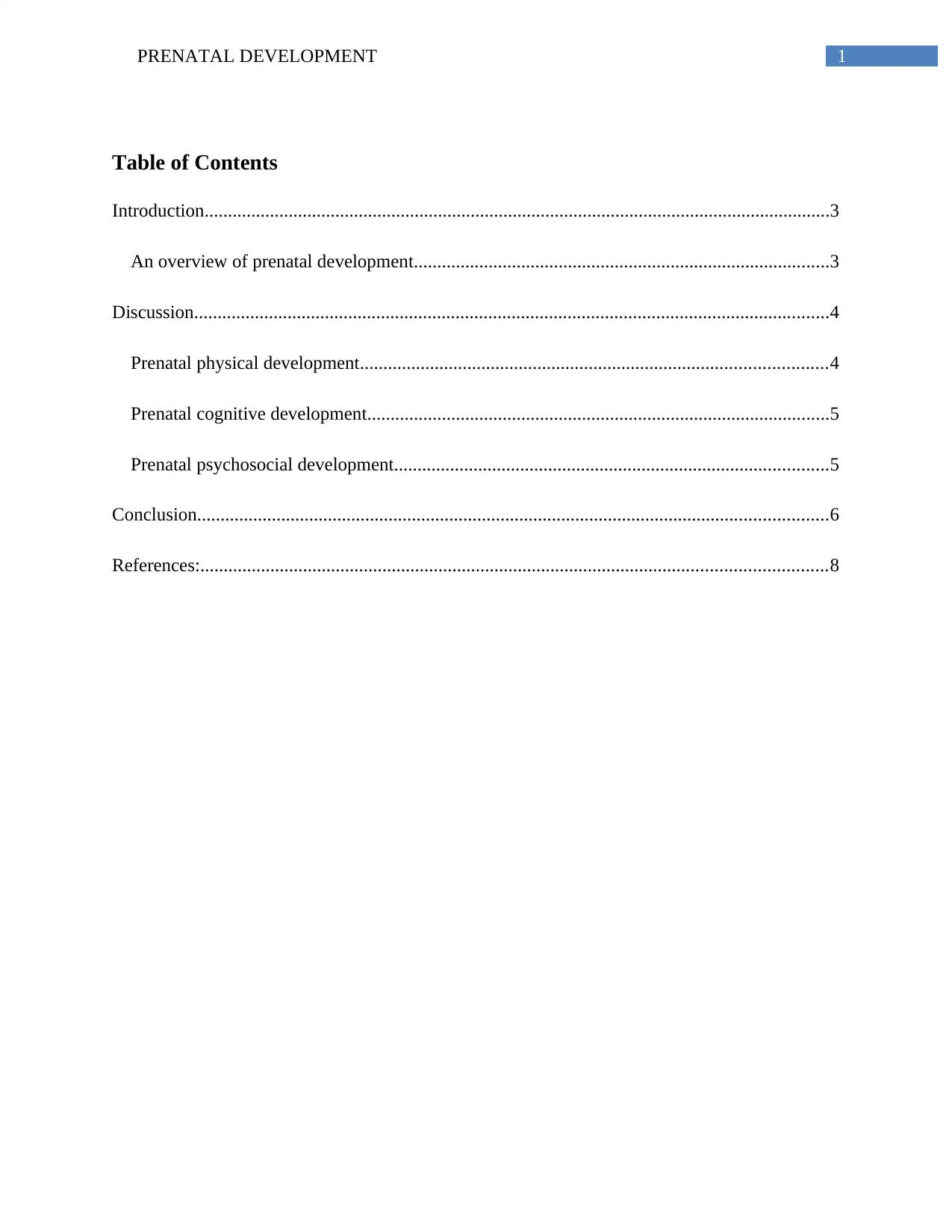
1PRENATAL DEVELOPMENT
Table of Contents
Introduction......................................................................................................................................3
An overview of prenatal development.........................................................................................3
Discussion........................................................................................................................................4
Prenatal physical development....................................................................................................4
Prenatal cognitive development...................................................................................................5
Prenatal psychosocial development.............................................................................................5
Conclusion.......................................................................................................................................6
References:......................................................................................................................................8
Table of Contents
Introduction......................................................................................................................................3
An overview of prenatal development.........................................................................................3
Discussion........................................................................................................................................4
Prenatal physical development....................................................................................................4
Prenatal cognitive development...................................................................................................5
Prenatal psychosocial development.............................................................................................5
Conclusion.......................................................................................................................................6
References:......................................................................................................................................8
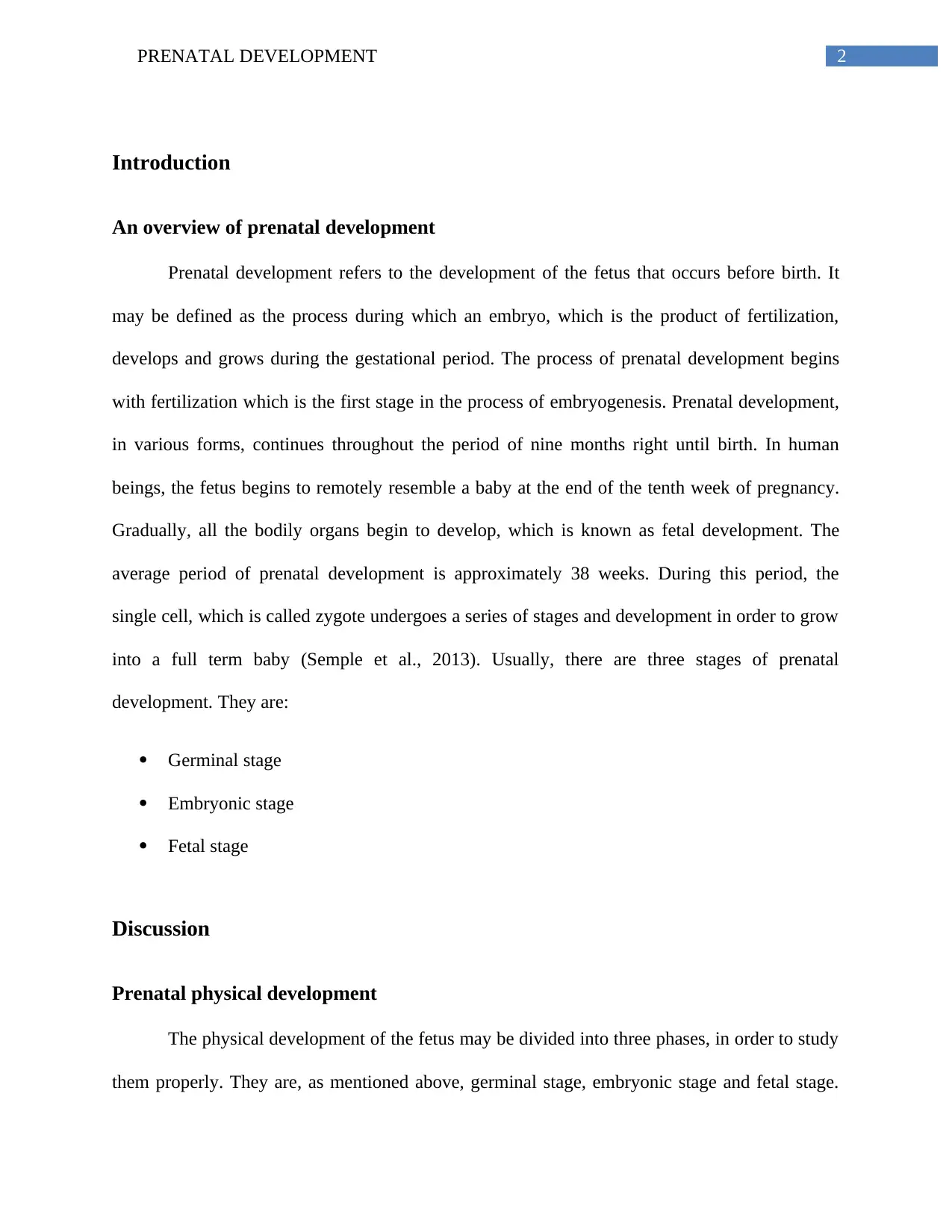
2PRENATAL DEVELOPMENT
Introduction
An overview of prenatal development
Prenatal development refers to the development of the fetus that occurs before birth. It
may be defined as the process during which an embryo, which is the product of fertilization,
develops and grows during the gestational period. The process of prenatal development begins
with fertilization which is the first stage in the process of embryogenesis. Prenatal development,
in various forms, continues throughout the period of nine months right until birth. In human
beings, the fetus begins to remotely resemble a baby at the end of the tenth week of pregnancy.
Gradually, all the bodily organs begin to develop, which is known as fetal development. The
average period of prenatal development is approximately 38 weeks. During this period, the
single cell, which is called zygote undergoes a series of stages and development in order to grow
into a full term baby (Semple et al., 2013). Usually, there are three stages of prenatal
development. They are:
Germinal stage
Embryonic stage
Fetal stage
Discussion
Prenatal physical development
The physical development of the fetus may be divided into three phases, in order to study
them properly. They are, as mentioned above, germinal stage, embryonic stage and fetal stage.
Introduction
An overview of prenatal development
Prenatal development refers to the development of the fetus that occurs before birth. It
may be defined as the process during which an embryo, which is the product of fertilization,
develops and grows during the gestational period. The process of prenatal development begins
with fertilization which is the first stage in the process of embryogenesis. Prenatal development,
in various forms, continues throughout the period of nine months right until birth. In human
beings, the fetus begins to remotely resemble a baby at the end of the tenth week of pregnancy.
Gradually, all the bodily organs begin to develop, which is known as fetal development. The
average period of prenatal development is approximately 38 weeks. During this period, the
single cell, which is called zygote undergoes a series of stages and development in order to grow
into a full term baby (Semple et al., 2013). Usually, there are three stages of prenatal
development. They are:
Germinal stage
Embryonic stage
Fetal stage
Discussion
Prenatal physical development
The physical development of the fetus may be divided into three phases, in order to study
them properly. They are, as mentioned above, germinal stage, embryonic stage and fetal stage.
⊘ This is a preview!⊘
Do you want full access?
Subscribe today to unlock all pages.

Trusted by 1+ million students worldwide

3PRENATAL DEVELOPMENT
The germinal stage being the first stage in physical development, occurs right after conception.
As part of the fertilization process the genetic material contained in the female egg and male
sperm combine to form one single cell, which is termed zygote. The zygote begins to rapidly
divide as part of the process called cleavage. First, the zygote divides into 2 identical cells which
are known as blastomeres. These cells then divide into four cells and the process continues.
Finally, after 16 cells have been formed, it is known as a morula. In the germinal phase of
prenatal physical development, the morula implants itself in the uterine wall (Dixon, 2017).
The embryonic stage of development lasts for a period of eight weeks. During this phase,
the following developments take place:
The heart, circulatory system, spinal cord, digestive system and other such organs
develop in week 3.
The facial structures, bone development, limbs and further development of the heart are
seen in week 4.
Eyes, nose, lungs, kidneys, further development of heart and brain are seen in week 5.
By week 8, the facial structures have become more distinct, the development of the heart
comes to an end and the internal sex organs have begun to develop (Doyle et al., 2015).
It is during the fetal stage that most of the physical development is observed. By the end
of the fetal stage, a fetus is approximately 50 cm in length and may weigh approximately 7.3
pounds. While most of the organs and body parts were developed in the embryonic stage, they
continue to grow and develop in the fetal stage until the fetus begins to resemble an actual baby.
The germinal stage being the first stage in physical development, occurs right after conception.
As part of the fertilization process the genetic material contained in the female egg and male
sperm combine to form one single cell, which is termed zygote. The zygote begins to rapidly
divide as part of the process called cleavage. First, the zygote divides into 2 identical cells which
are known as blastomeres. These cells then divide into four cells and the process continues.
Finally, after 16 cells have been formed, it is known as a morula. In the germinal phase of
prenatal physical development, the morula implants itself in the uterine wall (Dixon, 2017).
The embryonic stage of development lasts for a period of eight weeks. During this phase,
the following developments take place:
The heart, circulatory system, spinal cord, digestive system and other such organs
develop in week 3.
The facial structures, bone development, limbs and further development of the heart are
seen in week 4.
Eyes, nose, lungs, kidneys, further development of heart and brain are seen in week 5.
By week 8, the facial structures have become more distinct, the development of the heart
comes to an end and the internal sex organs have begun to develop (Doyle et al., 2015).
It is during the fetal stage that most of the physical development is observed. By the end
of the fetal stage, a fetus is approximately 50 cm in length and may weigh approximately 7.3
pounds. While most of the organs and body parts were developed in the embryonic stage, they
continue to grow and develop in the fetal stage until the fetus begins to resemble an actual baby.
Paraphrase This Document
Need a fresh take? Get an instant paraphrase of this document with our AI Paraphraser
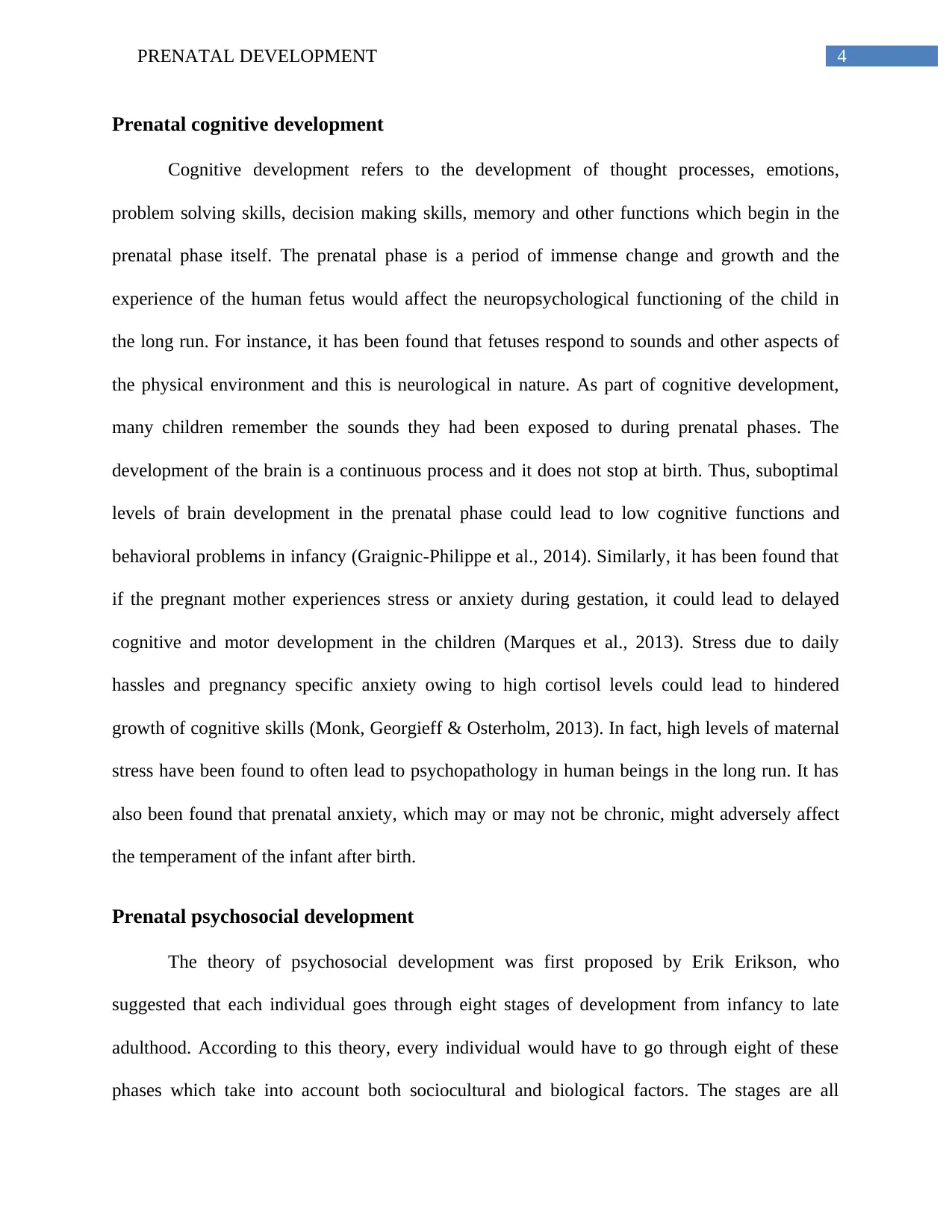
4PRENATAL DEVELOPMENT
Prenatal cognitive development
Cognitive development refers to the development of thought processes, emotions,
problem solving skills, decision making skills, memory and other functions which begin in the
prenatal phase itself. The prenatal phase is a period of immense change and growth and the
experience of the human fetus would affect the neuropsychological functioning of the child in
the long run. For instance, it has been found that fetuses respond to sounds and other aspects of
the physical environment and this is neurological in nature. As part of cognitive development,
many children remember the sounds they had been exposed to during prenatal phases. The
development of the brain is a continuous process and it does not stop at birth. Thus, suboptimal
levels of brain development in the prenatal phase could lead to low cognitive functions and
behavioral problems in infancy (Graignic-Philippe et al., 2014). Similarly, it has been found that
if the pregnant mother experiences stress or anxiety during gestation, it could lead to delayed
cognitive and motor development in the children (Marques et al., 2013). Stress due to daily
hassles and pregnancy specific anxiety owing to high cortisol levels could lead to hindered
growth of cognitive skills (Monk, Georgieff & Osterholm, 2013). In fact, high levels of maternal
stress have been found to often lead to psychopathology in human beings in the long run. It has
also been found that prenatal anxiety, which may or may not be chronic, might adversely affect
the temperament of the infant after birth.
Prenatal psychosocial development
The theory of psychosocial development was first proposed by Erik Erikson, who
suggested that each individual goes through eight stages of development from infancy to late
adulthood. According to this theory, every individual would have to go through eight of these
phases which take into account both sociocultural and biological factors. The stages are all
Prenatal cognitive development
Cognitive development refers to the development of thought processes, emotions,
problem solving skills, decision making skills, memory and other functions which begin in the
prenatal phase itself. The prenatal phase is a period of immense change and growth and the
experience of the human fetus would affect the neuropsychological functioning of the child in
the long run. For instance, it has been found that fetuses respond to sounds and other aspects of
the physical environment and this is neurological in nature. As part of cognitive development,
many children remember the sounds they had been exposed to during prenatal phases. The
development of the brain is a continuous process and it does not stop at birth. Thus, suboptimal
levels of brain development in the prenatal phase could lead to low cognitive functions and
behavioral problems in infancy (Graignic-Philippe et al., 2014). Similarly, it has been found that
if the pregnant mother experiences stress or anxiety during gestation, it could lead to delayed
cognitive and motor development in the children (Marques et al., 2013). Stress due to daily
hassles and pregnancy specific anxiety owing to high cortisol levels could lead to hindered
growth of cognitive skills (Monk, Georgieff & Osterholm, 2013). In fact, high levels of maternal
stress have been found to often lead to psychopathology in human beings in the long run. It has
also been found that prenatal anxiety, which may or may not be chronic, might adversely affect
the temperament of the infant after birth.
Prenatal psychosocial development
The theory of psychosocial development was first proposed by Erik Erikson, who
suggested that each individual goes through eight stages of development from infancy to late
adulthood. According to this theory, every individual would have to go through eight of these
phases which take into account both sociocultural and biological factors. The stages are all
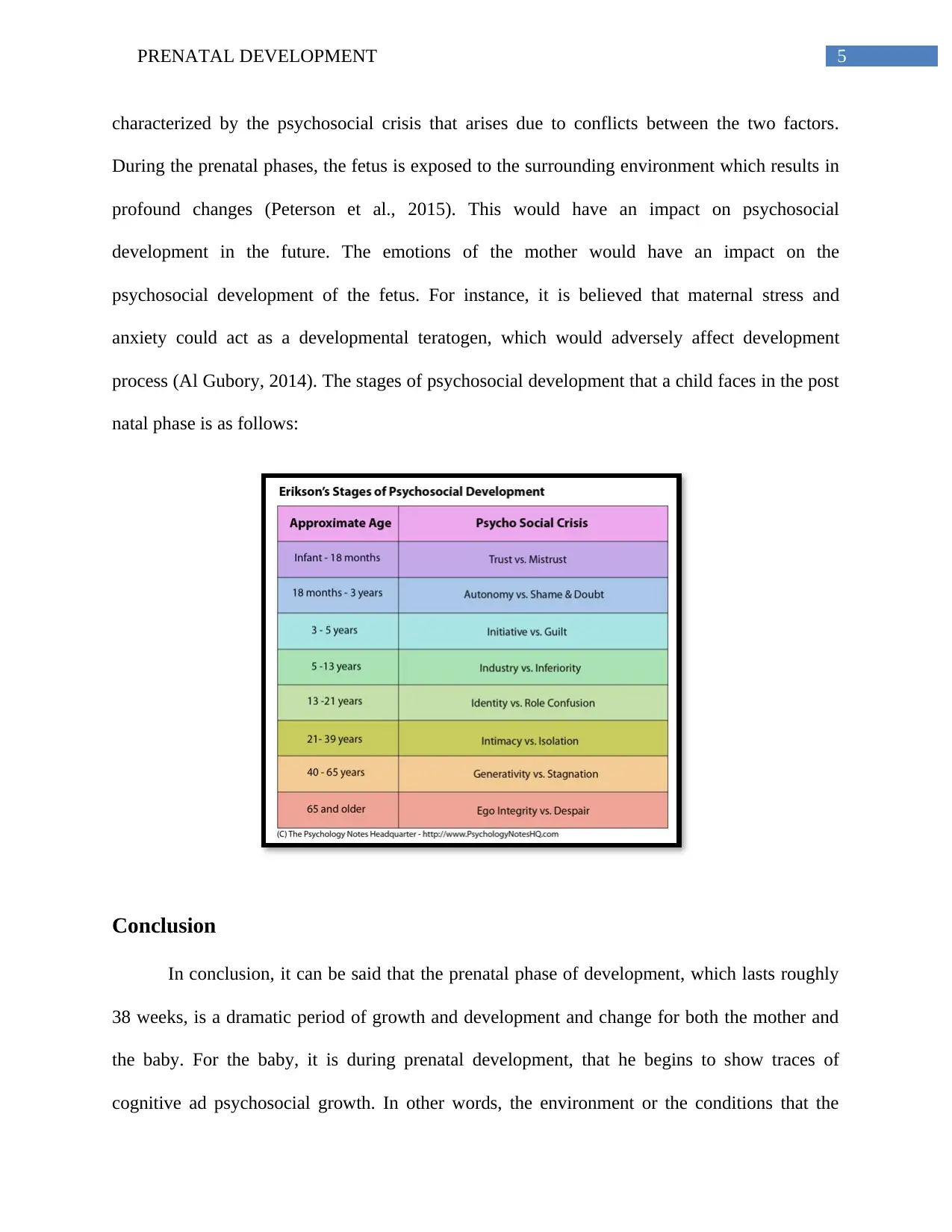
5PRENATAL DEVELOPMENT
characterized by the psychosocial crisis that arises due to conflicts between the two factors.
During the prenatal phases, the fetus is exposed to the surrounding environment which results in
profound changes (Peterson et al., 2015). This would have an impact on psychosocial
development in the future. The emotions of the mother would have an impact on the
psychosocial development of the fetus. For instance, it is believed that maternal stress and
anxiety could act as a developmental teratogen, which would adversely affect development
process (Al Gubory, 2014). The stages of psychosocial development that a child faces in the post
natal phase is as follows:
Conclusion
In conclusion, it can be said that the prenatal phase of development, which lasts roughly
38 weeks, is a dramatic period of growth and development and change for both the mother and
the baby. For the baby, it is during prenatal development, that he begins to show traces of
cognitive ad psychosocial growth. In other words, the environment or the conditions that the
characterized by the psychosocial crisis that arises due to conflicts between the two factors.
During the prenatal phases, the fetus is exposed to the surrounding environment which results in
profound changes (Peterson et al., 2015). This would have an impact on psychosocial
development in the future. The emotions of the mother would have an impact on the
psychosocial development of the fetus. For instance, it is believed that maternal stress and
anxiety could act as a developmental teratogen, which would adversely affect development
process (Al Gubory, 2014). The stages of psychosocial development that a child faces in the post
natal phase is as follows:
Conclusion
In conclusion, it can be said that the prenatal phase of development, which lasts roughly
38 weeks, is a dramatic period of growth and development and change for both the mother and
the baby. For the baby, it is during prenatal development, that he begins to show traces of
cognitive ad psychosocial growth. In other words, the environment or the conditions that the
⊘ This is a preview!⊘
Do you want full access?
Subscribe today to unlock all pages.

Trusted by 1+ million students worldwide

6PRENATAL DEVELOPMENT
pregnant mother and child are exposed to would have an impact on the temperament, behavioral
patterns and social development of the child in the long run. During prenatal development, the
fetus grows from a single cell into a full grown baby. In the process, the child undergoes a
number of changes which could potentially affect his growth and development as an infant and
as an adult.
pregnant mother and child are exposed to would have an impact on the temperament, behavioral
patterns and social development of the child in the long run. During prenatal development, the
fetus grows from a single cell into a full grown baby. In the process, the child undergoes a
number of changes which could potentially affect his growth and development as an infant and
as an adult.
Paraphrase This Document
Need a fresh take? Get an instant paraphrase of this document with our AI Paraphraser

7PRENATAL DEVELOPMENT
References:
Al-Gubory, K.H. (2014). Environmental pollutants and lifestyle factors induce oxidative stress
and poor prenatal development. Reproductive BioMedicine Online, 29(1), pp.17-31.
Dixon, A.D. (2017). Prenatal development of the facial skeleton. In Fundamentals of
craniofacial growth (pp. 59-98). CRC Press.
Doyle, C., Werner, E., Feng, T., Lee, S., Altemus, M., Isler, J.R. & Monk, C. (2015). Pregnancy
distress gets under fetal skin: Maternal ambulatory assessment & sex differences in
prenatal development. Developmental psychobiology, 57(5), pp.607-625.
Graignic-Philippe, R., Dayan, J., Chokron, S., Jacquet, A.Y. & Tordjman, S. (2014). Effects of
prenatal stress on fetal and child development: a critical literature review. Neuroscience
& biobehavioral reviews, 43, pp.137-162.
Marques, A.H., O'Connor, T.G., Roth, C., Susser, E. & Bjørke-Monsen, A.L. (2013). The
influence of maternal prenatal and early childhood nutrition and maternal prenatal stress
on offspring immune system development and neurodevelopmental disorders. Frontiers
in neuroscience, 7, p.120.
Monk, C., Georgieff, M.K. & Osterholm, E.A. (2013). Research review: maternal prenatal
distress and poor nutrition–mutually influencing risk factors affecting infant
neurocognitive development. Journal of Child Psychology and Psychiatry, 54(2), pp.115-
130.
References:
Al-Gubory, K.H. (2014). Environmental pollutants and lifestyle factors induce oxidative stress
and poor prenatal development. Reproductive BioMedicine Online, 29(1), pp.17-31.
Dixon, A.D. (2017). Prenatal development of the facial skeleton. In Fundamentals of
craniofacial growth (pp. 59-98). CRC Press.
Doyle, C., Werner, E., Feng, T., Lee, S., Altemus, M., Isler, J.R. & Monk, C. (2015). Pregnancy
distress gets under fetal skin: Maternal ambulatory assessment & sex differences in
prenatal development. Developmental psychobiology, 57(5), pp.607-625.
Graignic-Philippe, R., Dayan, J., Chokron, S., Jacquet, A.Y. & Tordjman, S. (2014). Effects of
prenatal stress on fetal and child development: a critical literature review. Neuroscience
& biobehavioral reviews, 43, pp.137-162.
Marques, A.H., O'Connor, T.G., Roth, C., Susser, E. & Bjørke-Monsen, A.L. (2013). The
influence of maternal prenatal and early childhood nutrition and maternal prenatal stress
on offspring immune system development and neurodevelopmental disorders. Frontiers
in neuroscience, 7, p.120.
Monk, C., Georgieff, M.K. & Osterholm, E.A. (2013). Research review: maternal prenatal
distress and poor nutrition–mutually influencing risk factors affecting infant
neurocognitive development. Journal of Child Psychology and Psychiatry, 54(2), pp.115-
130.
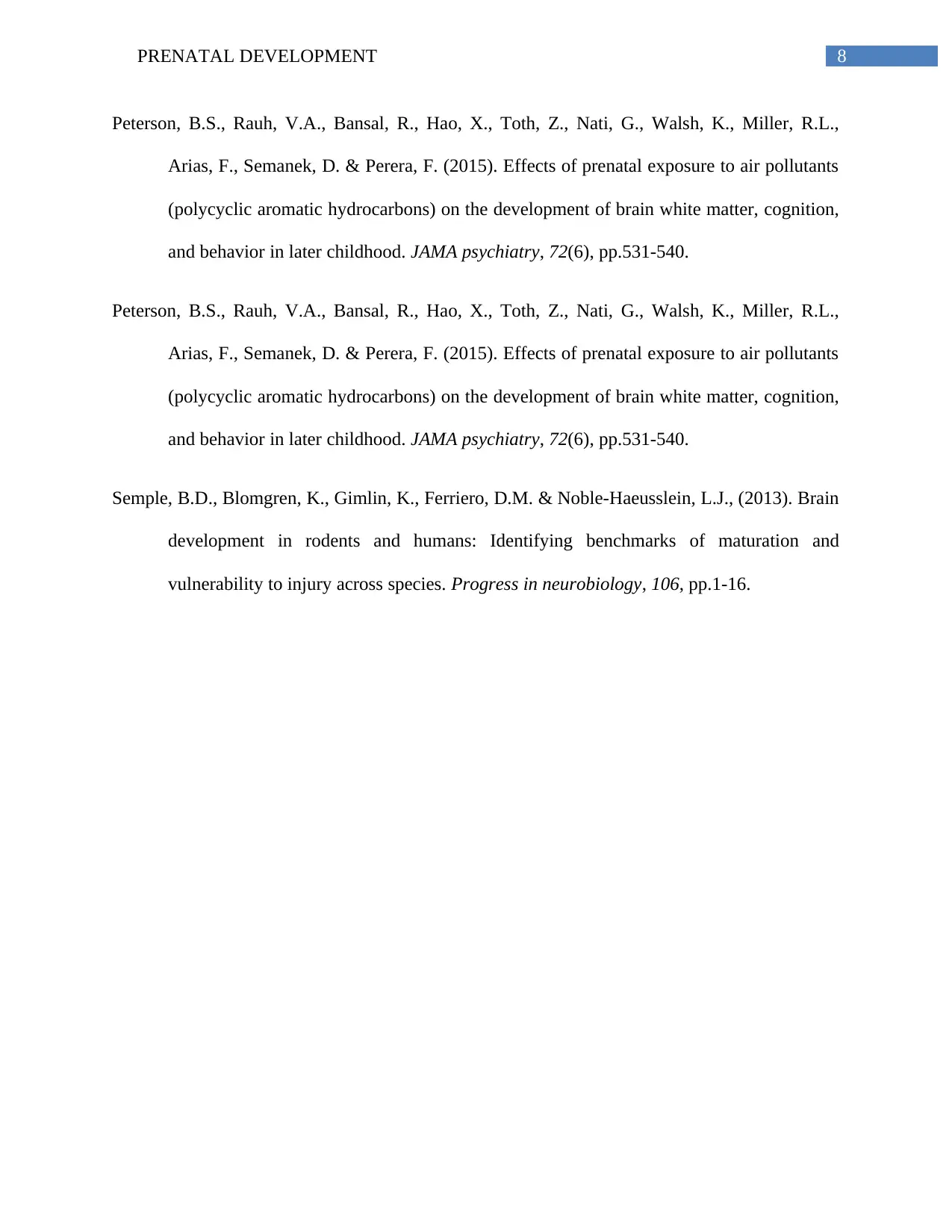
8PRENATAL DEVELOPMENT
Peterson, B.S., Rauh, V.A., Bansal, R., Hao, X., Toth, Z., Nati, G., Walsh, K., Miller, R.L.,
Arias, F., Semanek, D. & Perera, F. (2015). Effects of prenatal exposure to air pollutants
(polycyclic aromatic hydrocarbons) on the development of brain white matter, cognition,
and behavior in later childhood. JAMA psychiatry, 72(6), pp.531-540.
Peterson, B.S., Rauh, V.A., Bansal, R., Hao, X., Toth, Z., Nati, G., Walsh, K., Miller, R.L.,
Arias, F., Semanek, D. & Perera, F. (2015). Effects of prenatal exposure to air pollutants
(polycyclic aromatic hydrocarbons) on the development of brain white matter, cognition,
and behavior in later childhood. JAMA psychiatry, 72(6), pp.531-540.
Semple, B.D., Blomgren, K., Gimlin, K., Ferriero, D.M. & Noble-Haeusslein, L.J., (2013). Brain
development in rodents and humans: Identifying benchmarks of maturation and
vulnerability to injury across species. Progress in neurobiology, 106, pp.1-16.
Peterson, B.S., Rauh, V.A., Bansal, R., Hao, X., Toth, Z., Nati, G., Walsh, K., Miller, R.L.,
Arias, F., Semanek, D. & Perera, F. (2015). Effects of prenatal exposure to air pollutants
(polycyclic aromatic hydrocarbons) on the development of brain white matter, cognition,
and behavior in later childhood. JAMA psychiatry, 72(6), pp.531-540.
Peterson, B.S., Rauh, V.A., Bansal, R., Hao, X., Toth, Z., Nati, G., Walsh, K., Miller, R.L.,
Arias, F., Semanek, D. & Perera, F. (2015). Effects of prenatal exposure to air pollutants
(polycyclic aromatic hydrocarbons) on the development of brain white matter, cognition,
and behavior in later childhood. JAMA psychiatry, 72(6), pp.531-540.
Semple, B.D., Blomgren, K., Gimlin, K., Ferriero, D.M. & Noble-Haeusslein, L.J., (2013). Brain
development in rodents and humans: Identifying benchmarks of maturation and
vulnerability to injury across species. Progress in neurobiology, 106, pp.1-16.
⊘ This is a preview!⊘
Do you want full access?
Subscribe today to unlock all pages.

Trusted by 1+ million students worldwide
1 out of 9
Related Documents
Your All-in-One AI-Powered Toolkit for Academic Success.
+13062052269
info@desklib.com
Available 24*7 on WhatsApp / Email
![[object Object]](/_next/static/media/star-bottom.7253800d.svg)
Unlock your academic potential
Copyright © 2020–2025 A2Z Services. All Rights Reserved. Developed and managed by ZUCOL.





